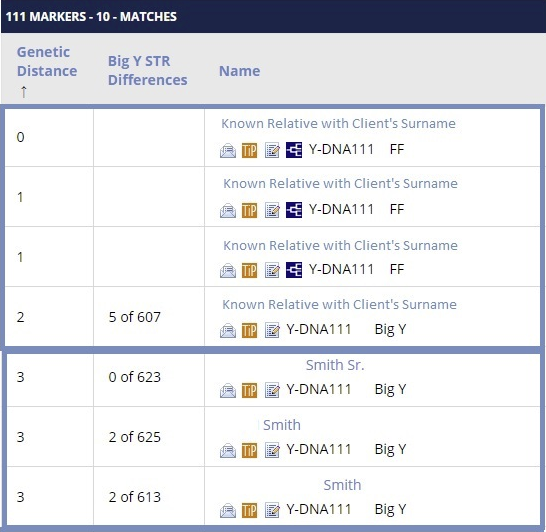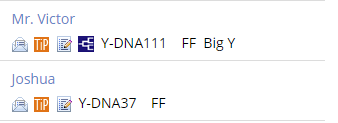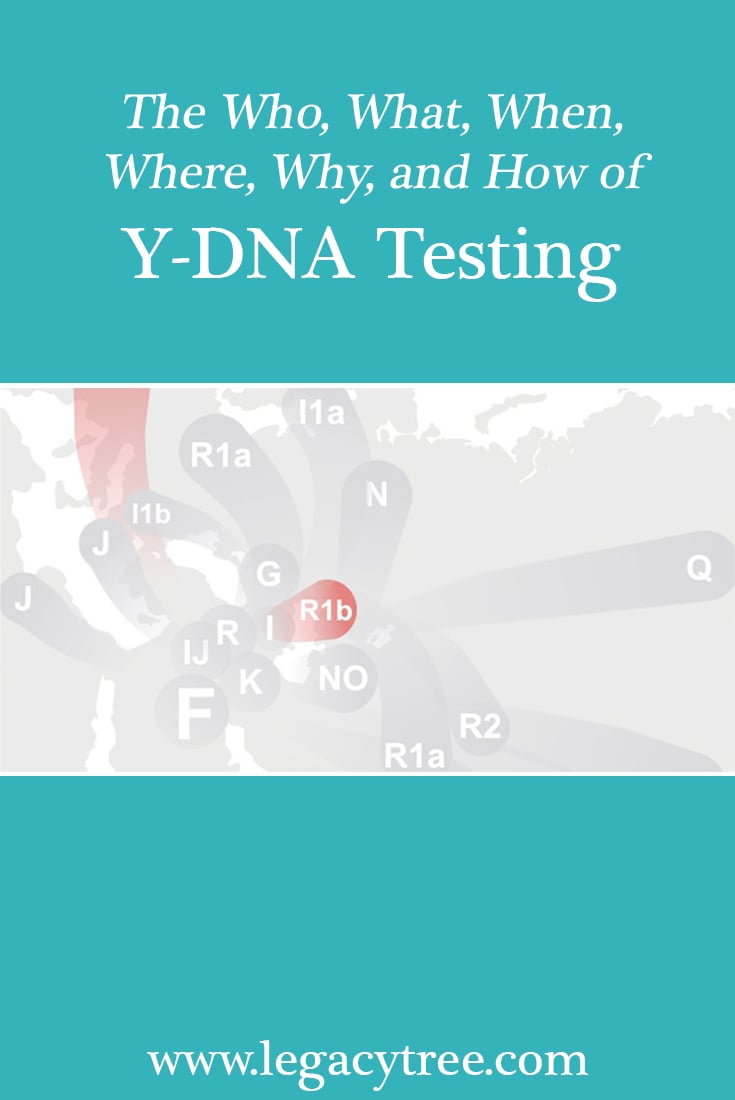Why is It (Realitively) Easy to Link Male Dna to Surnames?
What is Y-DNA testing, and what is it used for? We'll explain the who, what, where, when why, and how of Y-DNA testing, and its applications for genealogy.
DNA testing for genealogy has become really popular in the past few years, and incredible discoveries are being made through DNA testing that in many cases, could not be made any other way. Most of the recent attention has been on autosomal testing. However, Y-DNA testing also provides great genealogical value, and while more limited in scope, it can be a tremendous aid in breaking through more distant genealogical brick walls.
The testing coverage of the Y chromosome has increased in recent years, and the cost has dropped significantly, making advanced testing an option for more consumers. This article is not a how-to on interpreting results, but will discuss some basics of Y-DNA testing, and hopefully provide some ideas for how Y-DNA testing might further your genealogical research.
The Basics of Y-DNA Testing
Back to science class – we all have 23 pairs of chromosomes, with chromosomes 1-22 called the autosomes (and the focus of autosomal DNA tests such as MyHeritage, 23andMe, AncestryDNA, etc.) The 23rd chromosome is the sex chromosome. Women get two X chromosomes (one from Mom, one from Dad), and men get an X chromosome from Mom, and a Y chromosome from Dad.
Because a man has a single copy of the Y chromosome, that copy is passed intact to his sons, without recombination. While there can be occasional mutations, the Y chromosome often remains essentially identical for many generations through a paternal line. As a result, the Y chromosome can be used to discover deep paternal lineage, because it is not recombined every generation. The lack of recombination and relatively slow mutation rates mean that Y-STR results can help identify a family of interest, but in many cases will not identify which specific member of a family is your ancestor. However, Y-DNA testing will often provide enough clues to then use records-based research to find an answer to your research question.
Y-DNA testing has been commercially available for many years, but earlier testing included only Short Tandem Repeat (STR) tests. STR tests count the number of occurrences of an expected pattern in the Y chromosome, and compare the number with other testers. Some tested STRs are quite variable, and others may mutate, but then mutate back to the original value a few generations later. As such, STR-based tests are not the best indicator of how closely related two men are.
In recent years, Single Nucleotide Polymorphisms (SNPs) have been incorporated into some Y-DNA tests. SNP tests look for variations from the norm in individual positions on the chromosome. Once a SNP mutation occurs, it will typically be passed through subsequent generations and is unlikely to revert back to the default value. As such, SNP testing can be used to understand a genetic family tree (called a haplotree.)
SNP tests, such as the Big Y-700 test from FamilyTreeDNA, provide details on haplotree branching, as well as much better estimates of time to most recent common ancestor (TMRCA) than STR tests do.
Who Can Take a Y-DNA Test?
The short answer is, anyone with a Y chromosome. Your research question will help determine the best testing candidate for your particular situation. If you want to learn more about the family of your mother's father, Y-DNA testing your brother will not help, because your brother's Y-DNA came from your father's paternal line.
Females cannot take a Y-DNA test, and will need to recruit testers for any ancestral lines of interest. Males can Y-DNA test, but their results are only relevant to their direct paternal line, and they will need to recruit testers for any other ancestral lines of interest.
In many cases, descendancy research (tracing the descendants of a given ancestor) is needed to determine if any Y-DNA testing candidates are available. For more information on how to do this, review our article on Developing a DNA Testing Plan.
Sometimes there are no Y-DNA candidates from a given ancestor. My great-great-grandfather Robert Varner had five children, four of whom were daughters. Robert's only son (also Robert) had three sons: Robert (anyone see a trend here?), George, and Sola. Robert III never married, George had two sons and a daughter, and Sola had one son. However, the three sons of George and Sola all died as very young children. While my ancestor Robert Varner has plenty of living descendants, none are patrilineal (sons of sons of sons …) descendants. "Daughtered out" is a term used by some genealogists to describe a line with no patrilineal descendants.
If I want to use Y-DNA to learn more about Robert Varner's paternal line, I would need to look for patrilineal descendants of Robert's brothers, and if still no candidates were found, then go back a generation further. In some families, descendancy research to find a Y-DNA testing candidate may involve significant research.
What Can One Expect From Y-DNA Results?
Y-DNA tests provide a haplogroup prediction, along with matches with other testers. Haplogroups consist of people who descend from a common ancestor, although a basic haplogroup prediction from a Y-STR test is broad, consisting of men who descend from a common ancestor many thousands of years in the past. One's basic haplogroup prediction provides deep origins information, and the continent of origin for distant ancestors. For testers who want to know deep origins, but are uninterested in genealogy or matching, haplogroup predictions are also available through autosomal testing with 23andMe.
Y-DNA match lists are where genealogical value is found. Those who are familiar with autosomal DNA testing are accustomed to more DNA matches than one could ever possibly hope to individually study. Y-DNA tests almost always have a much smaller match list.
Y-STR testers are matched based on shared STR markers. At each level of testing, two men can mismatch on approximately 10% of the markers and still be considered a match. Y-STR match lists on FamilyTreeDNA include the name of the tester, a contact e-mail address, a family tree and earliest known ancestor information (if provided), the genetic distance between the two matches, a list of additional tests taken on FamilyTreeDNA (if any), and a more refined haplogroup (if the tester has done additional SNP testing or upgraded to Big Y.) Genetic distance does not represent the number of generations between two testers, but refers to the number of non-matching STR markers between the two. The ISOGG Wiki Genetic distance page contains several links with further explanation.

FamilyTreeDNA Y-STR Headings
Big Y-700 results show the tester's placement in the haplotree, along with other matching testers, provide details of the tester's private variants (variants shared with no one else in the database), as well as a list of non-matching variants with his most closely-matches testers. Interpretation of Big Y results is not for the faint of heart, but the potential discoveries from this data are incredible.
A Y-DNA test will typically have one of the following outcomes:
- Matches with other men with expected surname
- Matches with men with an unexpected surname
- Several surname groups
- N matches with N surnames
- No matches
The outcomes above are more or less ranked in order of desirability (i.e. – no one hopes for no matches.) I'll discuss them in reverse order.
No Matches
This is just as it sounds – some Y-DNA testers have no matches at all. As more and more people test, this outcome is less common than it used to be, but it still happens, usually meaning that a) the tester's ancient roots are from a less-tested part of the world, or b) the tester has unusual variants in his Y chromosome which prevent him from matching other testers.
N matches with N surnames
Sometimes we see Y-DNA results in which a tester has no surname pattern at all in his match list (for example, 11 matches with 11 distinct surnames.) When this occurs, the Y-DNA results are typically not immediately useful, and the best course of action is either to test known relatives to confirm lineage, or wait for new matches in hopes that a stronger surname trend might appear. An exception is in cultures in which permanent surnames are not used, or were adopted only in recent generations, such as Scandinavian cultures, in which patronymic naming conventions (using a variant of the father's first name for the child's surname) were used up until mid-to-late 1800s.
Several surname groups
From time to time, Y-DNA test results will include several different surname groups, with multiple matches from each surname. Upgrading testers to Big Y-700 may help determine which surname is actually the most closely related to the original tester.
Matches with men with an unexpected surname
The following image is a privatized version of results for one of my clients. Several of his close family members have tested, confirming their paternal lineage back to a shared great-grandfather. The bulk of their remaining matches have the surname Smith (which is not the client's surname.) This situation, in which a tester's lineage may be verified for a few generations, but Y-DNA reveals a surname change further back in time, is reasonably common.

Matches with men with the expected surname
These are the results everyone hopes for. It's exciting to see a Y-DNA match list with lots of matches to other men with your surname, preferably with well-developed family trees. Those trees can provide clues to help advance your documentary research, and may lead to discovery of unknown ancestors.
FamilyTreeDNA offers Y-DNA surname projects, in which results from men of the same surname can be compared. Some of these projects are actively recruiting additional testers, which not only helps current testers to explore their ancestry, but will also make research much easier for future testers.
When Should Y-DNA Results Be Utilized in Genealogy Research?
That somewhat depends on your research question. We typically don't recommend Y-DNA as a first course of action for research of unknown fathers, grandfathers, or great-grandfathers, as those questions can almost always be answered with autosomal DNA. For more distant ancestors, though, Y-DNA results can be invaluable. For research of second-great through fourth-great-grandfathers, we recommend first utilizing autosomal DNA to confirm the expected paternal line as far as possible, and then adding Y-DNA results to the mix.
A different type of "when" question is when to purchase. Of course, there's no time like the present, but when funds are limited, you may wish to wait until tests are on sale. There are several flash sales throughout the year, but the big Y-DNA sales are typically right before Christmas and Father's Day.
Where Can One Take a Y-DNA Test?
Only a few companies have Y-DNA tests available. FamilyTreeDNA is a good starting place for testing, and offers the largest database of matches. FamilyTreeDNA offers both STR tests (Y-37 and Y-111), along with Big Y-700, their SNP-based test. We recommend Y-37 as the initial test for most testers, to get a "lay of the land." If those results yield no or few matches, the tester has made a minimal financial investment and can wait for (or recruit) further matches before deciding to upgrade.
Why?
Why Test?
Typical reasons for Y-DNA testing include interest in ancient origins, or wanting to break through a genealogical brick wall. Y-DNA testing can also be used to confirm prior paper-trail research. While it is possible to confirm ancestry past fourth or fifth-great-grandparents using autosomal DNA results, it often can be extremely difficult to do so, and may require numerous testers to reach a sound genealogical conclusion. For more distant ancestors, targeted Y-DNA testing will typically confirm (or refute) one's expected paper trail far more expediently.
Why Upgrade?
The current regular price for Y-37 is $119, while Big Y-700 is $449. While that is substantially lower than the price was just a couple of years ago, it's still a large investment, which can be difficult to justify. In a professional research context, we often use Big Y-700 results to direct future documentary research. We've seen enough Y-111 genetic distance 0 matches who turned out to be not nearly as closely related as we had hoped. On the flip side, we've also been surprised by distant STR matches whose Big Y-700 results showed they were actually fairly closely related. As much as we would love for a Y-STR match list to accurately represent closest to most distant match, experience tells us that's not always the case.
Putting it all together (*surnames changed to protect privacy)
I have a client with surname *Baker, whose earliest known ancestor was born in 1785. He did a Y-37 test years ago, and was surprised to see that most of his Y-DNA matches had the surname Byrd. We tested another descendant of his earliest known Baker ancestor, to verify the line back to their shared ancestor from 1785. We also found a potential ancestor from the Byrd family – in the right place at the right time, and tested a descendant of that man. That tester was a strong Y-STR match to our client. We upgraded him and our tester to Big Y-700, and around the same time, other members of the Byrd family also happened to upgrade. Those results, unfortunately, made it very clear that the common ancestor between our client and the Byrd family was born before 1600, potentially hundreds of years before then. If we had stopped with Y-STR testing, our next research efforts would have undoubtedly been a waste of time, focusing on people who were not the client's ancestor. While the Big Y test was expensive, that money was well spent compared to the cost of researching the wrong family.
Farther down the client's Y-STR matches were several members of the Walters family. There were just a few, and they didn't have solid paper trails – foundlings, tales of paternity from traveling preachers, and the like. However, one of the Walters testers (who was the most distantly matched to our client on the Y-STR tests) who actually had a good family tree also upgraded to Big Y, and is significantly more closely related to the Bakers than the Byrd family was. This somewhat surprising connection to the Walters family has breathed new life into the Baker family's research.
It's easier to justify the upgrade to Big Y if some of your Y-STR matches have already taken the plunge. But at the end of the day, someone has to go first. Your test may be the one that encourages someone else to upgrade.

Victor has already upgraded to Big Y; Joshua has not
How Does One Take a Y-DNA Test?
Order the kit, and when it arrives in the mail, follow the instructions and return in the postage-paid package. Easy peasy. The hard part is the wait for the results to process (usually 4-6 weeks for a STR test, longer for Big Y-700.)
FamilyTreeDNA uses a swab for collection, instead of the spit method used by AncestryDNA and 23andMe. This method is often easier for older testers, or individuals with a dry mouth or other conditions which make it difficult to generate spit.
Final Thoughts
The increase in Y-DNA functionality and testers in the past three years have made Y-DNA results more genealogically viable than ever before. As databases continue to grow, these results will become even more useful. Not all testers will have results that are immediately helpful, but starting with a lower-cost test, and understanding possible outcomes may help reduce disappointment with sparse results.
If you have already Y-DNA tested and would like help with interpretation of results, or need help finding a candidate to test, we would love to help out!
Our resident DNA experts would be happy to help you analyze and make sense of the results you get from any of the major DNA testing companies. Give us a call or drop us an email and let us know how we can help you!

Subscribe for weekly posts
fletcherhustraings.blogspot.com
Source: https://www.legacytree.com/blog/y-dna-testing

0 Response to "Why is It (Realitively) Easy to Link Male Dna to Surnames?"
Post a Comment